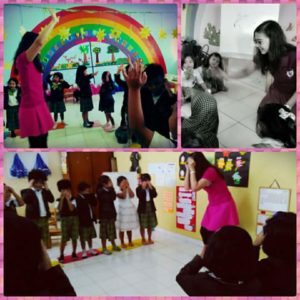This month we would like to honour teachers working on various stages of education across the world. In this issue, five teachers working in different contexts in four different countries – Japan, Indonesia, Greece, and the USA – describe an ordinary day in their teaching life, one out of many, and with their stories paint the routine with a splash of colours that are both joys and challenges.
Category: A day in the life of…
A Day in the Life of a Freelance Multitasker

It’s 6:30 a.m. and the alarm clock goes off. First coffee of the day and work begins.
I love waking up early in the morning, the peace and quiet are wonderful and I am ready for my first task. I am working on a translation now. One of my “jobs” is translating medical and sports-related texts. I work with trainer schools and sports professionals. I truly enjoy this kind of texts: I learn so much about the human body, the way it functions, methods how to improve our performance and avoid injuries, whether you are an athlete or not. There are so many sciences combined to actually train somebody (or yourself) – physiology, physics, sports science, medicine, chemistry, psychology… the list goes on. I admire sports professionals for using this knowledge to actually help their athletes improve. That’s also what we do as teachers, I guess. Combine the English language with technology and other subjects to make our lessons more useful and interesting.
Nine o’clock and I am off to class. Recently I have started working for a non-governmental organization. At the moment they are holding seminars and sessions for senior citizens, such as yoga, health-related seminars, as well as computer and English language lessons, and that’s where I come in! My class consists of eleven wonderful ladies over sixty. They were all very active during their youth, working and enjoying life, and in fact they still do. Although I do have a leaflet created by the organization with basic vocabulary and phrases, we usually improvise dialogues with related vocabulary, role-play trips to stores to buy stuff and going to restaurants. We focus on the language that they are going to need when travelling abroad. The funny thing is that, being “old-school” people, they are used to learning more grammar and rules, so they find it a bit bizarre to actually talk and communicate with each other in English, but it’s a lot of fun!
It’s almost noon and I am rushing back home to prepare lunch. If I lived alone, I wouldn’t be bothered, but having a kid makes all the difference. I am not good at cooking but I try to make something out of fresh ingredients, avoiding junk food and taking care of myself in this way.
Since it is summer, I don’t have a lot of one-to-one students, only a couple of adult learners a few times a week in the afternoon.
My first student is a teacher preparing for a literature exam, so I always bring excerpts from classic English literature, such as Jane Eyre, Wuthering Heights, or even Bram Stoker’s Dracula. We talk about the plot, analyze the characters, and compare the books with one another. The preparation I have to do at home is pretty demanding but I love every minute of it, because I get to read books and I have no excuses since I have to use them in my work.
My second student of the day is a businessperson who needs English to get around. I look for articles about food and drinks, travelling, and different cultures on the Internet. I create reading comprehension and vocabulary exercises and then we talk about the subject I have chosen for the day. My student has travelled almost everywhere in the world, so the experiences he shares are very interesting, sometimes funny, sometimes enlightening. Working without a coursebook is a great experience for me because it keeps me motivated to create new things myself. Not that I don’t like coursebooks – I do use them for my lessons with children and teenagers, as well as preparing for exams, but when you teach ESP you have to be creative, I guess.
After my private lessons, it’s spinning time! Well, for those of you who don’t know what it is, I will explain. Spinning is a gym class on a stationary bike. You may tell me, “What kind of class is this, you just get on the bike and ride!” But it’s so much more than that. You can have a complete workout with sprints, climbing hills, or even jumps with great music. I love this class so much that a few years ago I actually went to a spinning instruction school and got my own trainer diploma. I learned about human physiology, heart rates, different kinds of bikes, and all about beat and music used in the process. Spinning combines my three big loves: teaching, music, and movement, and that’s why I love it so much! So every weekend I try to spend a couple of hours discovering new music and creating my “lesson-plans” with the right moves. What I find really challenging in this type of teaching is that you never get to have the same students like in a normal language class, and the fact that their levels are different never makes it any easier. You can have an athlete, a pensioner, and a housewife all in the same class! So, when planning, you have to create different versions of moves, a lighter one and a more difficult one. This reminds me of mixed ability classes and the need for us teachers to have activities that cover the same language phenomenon while catering for different language levels and individual abilities of our students.
It’s late in the evening. I am back home, to tidy up and talk to my kid a bit more. Tomorrow is another day. And a new challenge.
It’s Always Sunny in Kidea

Whenever I tell people that I am a kindergarten teacher, they always say “Wow, you are so lucky to be playing with children every day!” Well, that’s not all wrong, but if you think that what I do all day is holding hands and singing, then you need to step in my shoes for one day (or rather socks as I wear socks in the classroom).
Let me take you through a day in one of the first few weeks of this school year of my K1 class.

It was 7:45 in the morning. I was already in my Montessori classroom with materials ready to go and felt very excited and optimistic about the day, though the last few days had not been easy. Some of my four-year-old students started coming to the classroom. One girl who had been with us since the previous level entered with a beautiful smile, said hi to me and my assistant, and washed her hands before sitting on the carpet to play while waiting for the others. Some boys came in and started playing, too.
8 a.m., time to start class. As usual, I gathered the students on the carpet and started the lesson. As we began to pray, one more student came in. She didn’t enter though, she just kept standing by the door, with her backpack on and not letting go of the door handle. My assistant tried to persuade her to join us but she wouldn’t let go of the door. The girl screamed and started to cry so my assistant stayed with her as I tried to continue the class greetings. Another girl, who was already sitting on the carpet with the rest, didn’t like the fact that I asked them to jump to the song, so she started kicking and screaming. I tried to calm her down but then she kicked me and pulled my hair. Just then the administrator came in with two new kids, who were twins. They didn’t want their mom to leave them but she had to, so they started crying. I carried one of them in but the other pulled my hand and asked to be carried along, too. So there I was, sitting on the carpet, with both of the new kids on my lap, trying to start my presentation. I laid my mat and placed my model farm animals on it. One of the boys took the horse and started playing with it, and I couldn’t move fast enough to grab it back from him because I already had two children on my lap and my assistant was still trying to calm the tantrum girl down and the one who was still by the door. The 15-minute presentation dragged for much longer and didn’t finish in the end, though I somehow managed to present the topic.
After the failed presentation, we had some individual learning time which turned out to be a little chaos of its own. One kid was throwing around all of the rice from the bowl instead of spooning it from one bowl to another; another kid tore the paper out of one of the reading books because he loved the picture in it. The chaos had many other “activities” that can only be described as “not in the lesson plan.”
Then we headed off to the gym for some obstacle course time. Even though most kids wouldn’t do as we had shown them, some actually tried to perform the whole routine. After that we had snack time planned. I called my students in two by two to wash their hands, took their bags and eating mats, and set their tables to eat. We prayed before the meal and I showed them how to eat properly. Surprisingly, though they were very active and noisy during lesson, they were all behaving very well during snack time, even the crying, kicking, and sulking ones.
After snacks we had a Mandarin Chinese lesson, where my job was to help our teacher of Mandarin to maintain order in the classroom. But then it meant most kids would try to sit on my lap or at least close to me.

Finally, it’s time to go home. We said our pray, sang our goodbye song, and marched to be dismissed. My students were all smiling and some even hugged me and told me that they loved me. My hair was a mess, the two air-conditioners in the classroom couldn’t stop me from sweating because of all the chasing around, my T-shirt had food stains on it and was wet from tears, and I didn’t feel that I looked decent at all and was happy to catch a breath.
But guess what? I’d do it all over again the next day! Because the kids bring sunshine to my life and that’s why I know I’m lucky to be their teacher.
One Day In the Life of a Language School Teacher in Jakarta

It was eight o’clock on a Monday morning and everyone in the city was busy heading to their offices. As I walked out of my house, I saw three guys in formal suits walking towards the train station and talking to each other. A man in a yellow shirt and black pants was talking to his companion passionately, waving a roll of newspaper in his right hand as he spoke. On the opposite side of the street I saw two school girls wearing white hijab uniform walking together, the taller one whispering something to the other, who then responded with giggles. Next to the train station there was a lady in her nightdress and a pink veil carrying a bag of vegetables from the traditional marketplace located nearby. Some motorcycles were passing by.
These are the scenes that happen pretty much every morning. I am lucky to not be as busy as most of the working people whose day always starts from early morning; or as the school girls who should be at school at 6:30 a.m.; or as any of those other people that I saw. My own mornings are usually more laid-back, except for some rare days when I have to work early and commute to other schools. Like that Monday morning, when my office sent me to a kindergarten to give a demo class as part of promotional and marketing program. I was excited as this opportunity would give me a nostalgic kind of feeling because I was to teach young learners, like used to. The school I was heading to is not far from my place, so I only needed to go by public motorcycle to save time. Wearing the school’s pink polo shirt and pink skirt, I was ready to feel the joy of teaching young learners once again.
It was now 10:40 a.m. and I had just finished the demo class. It was exhausting but I really enjoyed teaching the kids; we sang, played, jumped around and were silly together. I wanted to stay and play with them a bit longer but it was time for me to head to the school where I teach on a regular basis. I ordered the transportation service from my mobile phone and they arrived in no time. Going places in Jakarta has become hassle-free ever since those kind of companies took over the country. The journey to my school did not take a long time either, it was only 40 minutes without any traffic jam.
That day I had three classes: primary school students aka the HighFlyers at 3:00 p.m.; teenagers aged 15-18 years old aka Frontrunners at 4:30 p.m.; and the TOEFL class for adults from 6:40 till 8:40 p.m. Since it was still eleven o’clock when I arrived at work, I had time to have lunch and prepare for classes. The preparation doesn’t actually take long as the syllabi and all the materials are already provided online, which makes it easy for all teachers to access them. Besides, the first class of the day was scheduled to have a progress test and computer lesson in the iLab (computer room), so I only needed to print their test papers for that. However, I knew the test wouldn’t last for the whole lesson, that’s why I planned something special for the remainder of our class time. As there had just been a government election in Indonesia, we run a short simulation of a real election in class. It was really fun and students loved pretending to be the candidates and vote whilst using the language creatively. When the class finished, although there was not much time left, I had to take attendance online and make notes on what was covered in class on the school’s website before I went back to the teachers’ room.
After a short ten-minute break came the Frontrunners class. It was a group of five girls and the lesson seemed more relaxing as they were not as active as the HighFlyers. I loved giving these students some discussion topics so they could enjoy practising speaking English instead of doing a lot of written work. In fact, this is one of the important moments that my colleagues and myself need to understand: working in a private language school, we shouldn’t force students to do as much homework as they get at their regular schools that they attend in the morning.
My last class of the day, the TOEFL class, was the one that needed more preparation and focus as this is a group of adults determined to achieve their clear goals of getting a certain score in the test, unlike other adult classes I teach that focus on General English, Business English, or English Conversation and which are more relaxing. My colleagues told me to be strict and formal in this TOEFL class, but I chose to do it my own way. I gave them additional activities that were a bit more fun, so the students wouldn’t be bored. As this class consisted of a group of brilliant students, who loved discussing and sharing their opinions with outstanding vocabulary and general knowledge, I had to prepare more challenging activities to engage them. That day, we did the Would You Rather quiz with out-of-this-world questions (such as “Would you rather be stupid in a world of smart people or smart in a world of stupid people?”). I was surprised that they enjoyed doing it, and I made a note that I should think of more challenging (and fun) activities for our next class. Till the end of the lesson we practised for the speaking and writing test on the topic of storytelling and students had a creative task of comparing someone to a cockroach.
It was 8:40 p.m. when the class was over and I didn’t realize the time had flown so fast. That is why I love teaching. I might be exhausted by the end of the day but it all pays off with satisfaction I get from teaching. As I headed back to the teachers’ room, I watched the students carry their bags and walk out of the centre. Lights in some classrooms had already been switched off, which meant I needed to rush. I ordered another public motorcycle online and prepared to go home. The mall where my school is located was still crowded, with people window-shopping and walking around. Outside, the public motorcycle was already waiting for me among many other motorcycles waiting for other passengers.
What a day, but it was just one of the many similar days in my routine. I’ve been doing this for five years and, I must say, I truly enjoy and feel blessed teaching here.

A Day in the Life of an Eikaiwa Teacher

It is 5 a.m. She wakes up and springs out of bed. The sun is up, too, and the day is bright. Mornings are free for leisurely breakfasts, bicycling or hiking, keeping up with social media, or other projects that might come up. Today she has promised to answer the 19 student letters that arrived from Korea by post last month. The task takes the whole morning, interspersed with coffee breaks, social media breaks, and general breaks. Memories of a day in the life of an English conversation school teacher in Korea surface and she indulges them briefly before putting them away. Her new life as an English conversation school (eikaiwa) teacher in Japan is not so intense.
Letters finished, it’s time to get ready for the main part of the day. She has dressed carefully in loose pants and a super-mario alphabet t-shirt. She makes sure her monster-shaped pencil case is in her bag. Now she checks on the small things: wallet, keys, phone, earbuds, watch, bracelet. Ready. If she leaves now, she has 30 minutes before she has to be at work. Enough time to ride the pretty way. Leaving her apartment, she carries her bicycle down the stairs.
She arrives at school at eleven. She leaves her shoes at the door and enters the cool, air-conditioned school in her bare feet. The toddler class is just letting out, so she dumps her bag and goes in to play with them for a few minutes. It’s a good way to start the day. Once they’ve gone, she starts her task for the morning: cutting out ice cream scoops and cones for the kids to color and build during their craft this afternoon. There are even cherries and whipped cream that is rather unfortunately-shaped. Her lesson planning is finished. Entering her classroom, all she needs to do is set up the activities. She counts her flashcards and checks that they are in the order she wants, making sure one or two are upside down or backwards.
It’s 2:00 now and the classroom assistant has arrived. Together they run through the schedule, noting any special circumstances. Since today is a craft day, that demands extra work on both their parts. They role play how the craft will go.
Now the students are arriving for the first class. They play for a few minutes until the “official” start time. There are five kids. They are mostly three and four years old. Today’s class starts with a “Hello” song. Then they all sit in a circle on a carpet. “What’s your name?” she asks around the circle. Today they all answer confidently and only two need help. She shows them flashcards as a quick review, and three of them are very confident about all the words. She makes a mental note that the two who are not also didn’t want to say their names. Then she introduces the craft. The school has no tables or chairs, so the students grab a couple benches that line the edge of the room and make a table. She hands the craft part of the class over to the assistant and sets up another part of the classroom for one-on-one. She calls students over one at a time to check whether they have learned the theme of the semester. This semester it is body parts, and one by one the kids point to their bellies, stomp their feet, count their fingers…. By the time she’s checked with all five kids, they’ve also built their ice cream cones sky-high, and no one has touched the unfortunately-shaped whipped cream. Two kids didn’t quite finish their craft. Yep, the same two.
Outside, the assistant talks to the parents about their kids’ progress. The next class starts in ten minutes, so the teacher is inside hiding small flashcards and starting the music for the song she wants to teach today. There are six kids in the next class. They are six and seven years old. She greets them at the door and explains the activity to them before turning them loose to find the hidden flashcards. Then they count to make sure they have them all (Oh no! One is missing! Did you check your pockets? No, no, not my pocket! Ahhhhhhhhhh! Tackled by six six-year-olds!). She follows up the game with the new song and returns to the flashcards. The flashcards are the words for their new unit. They go through them with games and she checks that they can identify the pictures and words. That makes it easier to focus on individual sounds. Today they focus on ‘P’. They practice writing, and she makes a note of which kids are left-handed. Sky writing and tracing helps her show these kids how to form the letters. Now it’s time to chant, and then it’s time for a story before the kids go home. 50 minutes go fast, but the next class starts in 10, so she wraps it up.
This class has five sixth-graders, and they are a very different group from the previous classes. They start the class seated on the carpet in a circle. Everyone contributes something to the beginning of the class: a short sentence about whatever is new in their lives. K had a swimming tournament last week. M went to an onsen (a Japanese hot spring) with her friends. They spend ten minutes talking like this, and then it is time for more structured activities. They review question words — something they’ve been struggling with for several weeks now — and play a game she learned from observing a teacher at another school. They practice reading and Y reads his story to the class. They turn to their worksheet and start the last activity. The students have to complete it for homework because their hour is up. The next class starts in ten minutes.
The last class is the most challenging. There are three girls – two are 10 and one is 11 – and they are silent. Today is fun, though. She starts in the circle, exchanging greetings and explaining the day’s schedule to them. They are very attentive and nod in agreement. The class alternates between group work and independent work, and she notices they are a lot louder when the other girls aren’t listening. The rest of the group activities are ones they are all confident with – like reading aloud and question-and-answer drills – and by the end of the class, they are all smiles. All three stay later to play with each other.
It’s almost 8 p.m. and only M’s mom hasn’t arrived yet. She reads together with M while they wait. It’s dark, so she walks her to the door and watches them drive away. Then she vacuums the classroom and goes through the class files for the day, transferring her mental notes onto physical paper and adding notes of which activities went well or need more practice. She’s the last to go, so she closes up the school and rides her bike home. There’s just enough time before bed to study Japanese and have dinner. Tomorrow is another day.







